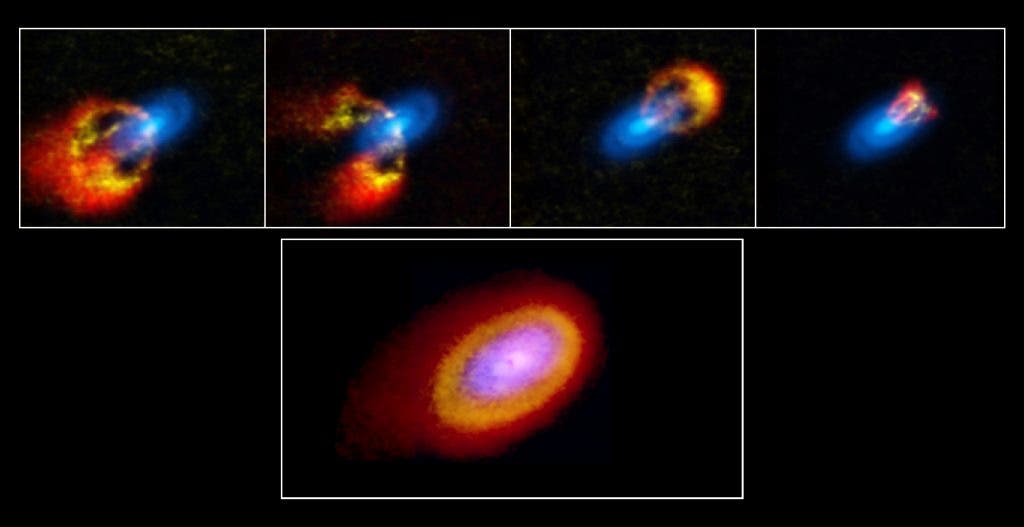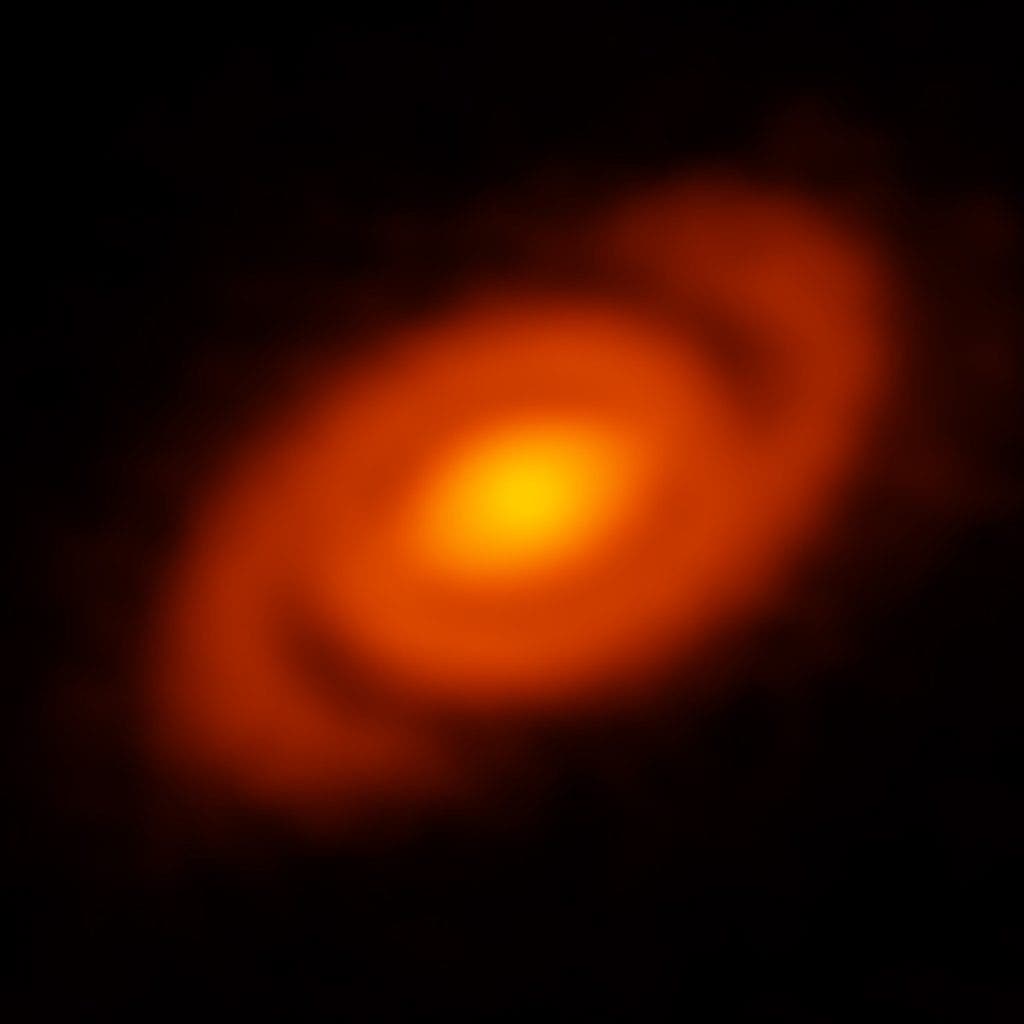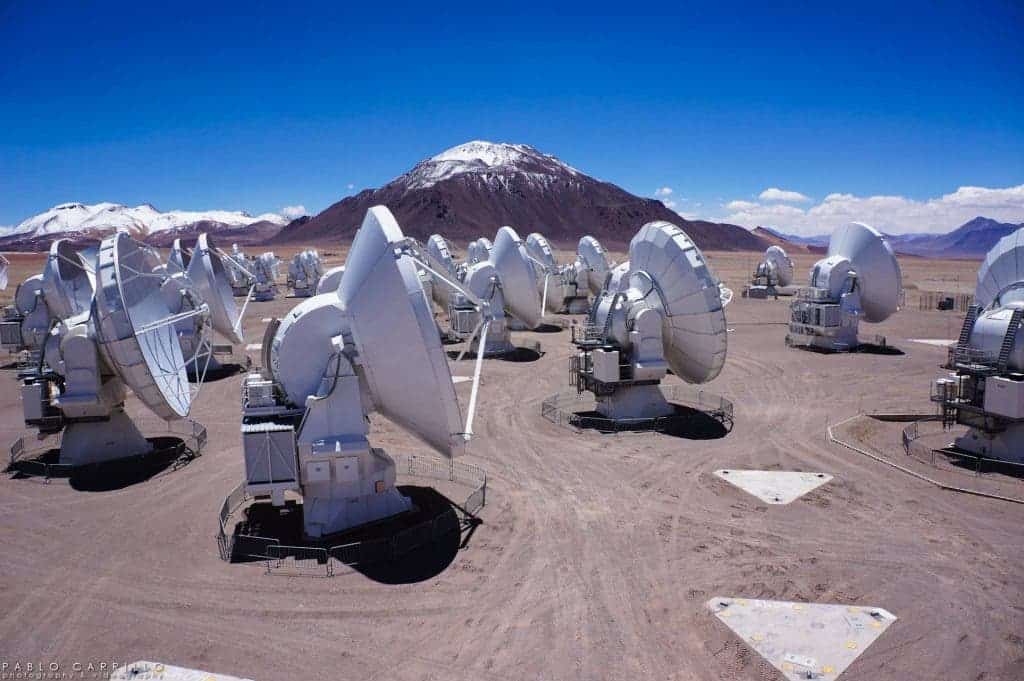One of the major problems which has hindered our understanding of planet formation has been the lack of direct measurements of the mass of planet-forming protoplanetary discs. Now, by successfully measuring the mass of a unique protoplanetary disc for the first time, astronomers have confirmed that gravitational instabilities play a key role in the formation of planets.
The team of astronomers, led by Teresa Paneque-Carreño, a PhD student at the University of Leiden and the European Southern Observatory (ESO), used gas velocity data collected using the Atacama Large Millimeter/submillimeter Array (ALMA) to make observations of the young star Elias 2-27 which is surrounded by a disc of gas and dust with some extraordinary features.
The star which is located just under 400 light-years from Earth in the constellation Ophiuchus has been a popular target for investigation by astronomers for at least five decades which paid off in 2016 with the discovery that the young star is surrounded by a disc of gas and dust. This marks the first time, however, that such a mass measurement has been made and gravitational instabilities have been confirmed.

“How exactly planets form is one of the main questions in our field. However, there are some key mechanisms that we believe can accelerate the process of planet formation,” explains Paneque-Carreño. “We found direct evidence for gravitational instabilities in Elias 2-27, which is very exciting because this is the first time that we can show kinematic and multi-wavelength proof of a system being gravitationally unstable.
“Elias 2-27 is the first system that checks all of the boxes.”
Teresa Paneque-Carreño, University of Leiden
Paneque-Carreño is the first author of one of two papers detailing the team’s findings–which give astronomers the key to unlocking the mystery of planet formation– published in the latest edition of The Astrophysical Journal.
What makes Elias 2-27 the Ideal System for Cracking the Planet Formation Mystery?
Researchers have known for some time that protoplanetary discs of gas and dust surrounding young stars are locations of planet formation and we have certainly no shortage of studies of such structures. But, despite having this knowledge and a wealth of observational data, the exact process that leads to the birth of a planet has remained a puzzle.

Fortunately, telltale evidence of gravitational instabilities around Elias 2-27 made it the ideal star for astronomers in order to conduct a thorough investigation of planet formation.
“We discovered in 2016 that the Elias 2-27 disk had a different structure from other already studied systems, something not observed in a protoplanetary disk before: two large-scale spiral arms,” remarks principal investigator Laura Pérez, Assistant Professor at the Universidad de Chile. “Gravitational instabilities were a strong possibility, but the origin of these structures remained a mystery and we needed further observations.”
It was Pérez who suggested that ALMA–a series of 66 radio telescopes located in the Atacama Desert of northern Chile–should be trained on the spiral of gas and dust surrounding this young star.
It was this further study that revealed, not only does Elias 2-27 possess a protoplanetary disc with signs of gravitational instabilities within it, it also has something unique for such a structure: spiral arms.
Elias 2-27: A Unique and Chaotic Young Star System
The presence of spiral arms in the protoplanetary disc is believed to be the result of perturbations caused by density waves throughout the gas and dust that comprise it.
It is the first star-forming disc discovered with such features. But, to Paneque-Carreño it signals the presence of something else within the disc, chaos. This chaotic nature also gives rise to another characteristic never seen in a disc such as this.
“There may still be new material from the surrounding molecular cloud falling onto the disc, which makes everything more chaotic,” says the graduate of the Universidad de Chile. “The Elias 2-27 star system is highly asymmetric in the gas structure. This was completely unexpected, and it is the first time we’ve observed such vertical asymmetry in a protoplanetary disc.”

It is the double-punch of this vertical asymmetry and large-scale perturbations giving rise to a spiral structure that Cassandra Hall, Assistant Professor of Computational Astrophysics, University of Georgia, believes has major implications for our theories of planet formation.
“This could be a ‘smoking gun’ of gravitational instability, which may accelerate some of the earliest stages of planet formation,” says Hall, a co-author of one of the papers detailing these findings. “We first predicted this signature in 2020, and from a computational astrophysics point of view, it’s exciting to be right.”
This research has cracked the problem of measuring the mass of a protoplanetary disc, thus removing a significant barrier in our understanding of planet formation. This was possible in large part due to the high sensitivity of ALMA’s observing bands, particularly band 6 which covers light with a wavelength of 1.1 to 1.4 nanometres in combination with bands 3 and 7–which cover 2.6 – 3.6 nm and 0.8 -1.1 nm, respectively.
“Previous measurements of protoplanetary disc mass were indirect and based only on dust or rare isotopologues. With this new study, we are now sensitive to the entire mass of the disc,” says the second paper’s lead author Benedetta Veronesi, a postdoctoral researcher at École normale supérieure de Lyon. “This finding lays the foundation for the development of a method to measure disc mass that will allow us to break down one of the biggest and most pressing barriers in the field of planet formation. “
“Knowing the amount of mass present in planet-forming discs allows us to determine the amount of material available for the formation of planetary systems, and to better understand the process by which they form.”
Benedetta Veronesi, École normale supérieure de Lyon
More Planet Formation Mysteries to Solve
Even though this research has answered some of the questions surrounding the process of planet formation, like the best scientific discoveries, it has also given rise to new questions.

“While gravitational instabilities can now be confirmed to explain the spiral structures in the dust continuum surrounding the star, there is also an inner gap, or missing material in the disk, for which we do not have a clear explanation,” explains Paneque-Carreño.
Many of these questions are difficult to answer because of the vast difference between the timescales on which we live and those taken by the processes that birth planets.
“Studying how planets form is difficult because it takes millions of years to form planets. This is a very short time-scale for stars, which live thousands of millions of years, but a very long process for us,” said Paneque-Carreño. “What we can do is observe young stars, with disks of gas and dust around them, and try to explain why these disks of material look the way they do. It’s like looking at a crime scene and trying to guess what happened. “
Fortunately, researchers like Paneque-Carreño, Cassandra Hall, and Benedetta Veronesi are prepared to tackle this monumental challenge and solve planet formation’s remaining mysteries.
“Our observational analysis paired with future in-depth analysis of Elias 2-27 will allow us to characterize exactly how gravitational instabilities act in planet-forming discs and gain more insight into how planets are formed,” concludes Paneque-Carreño.






